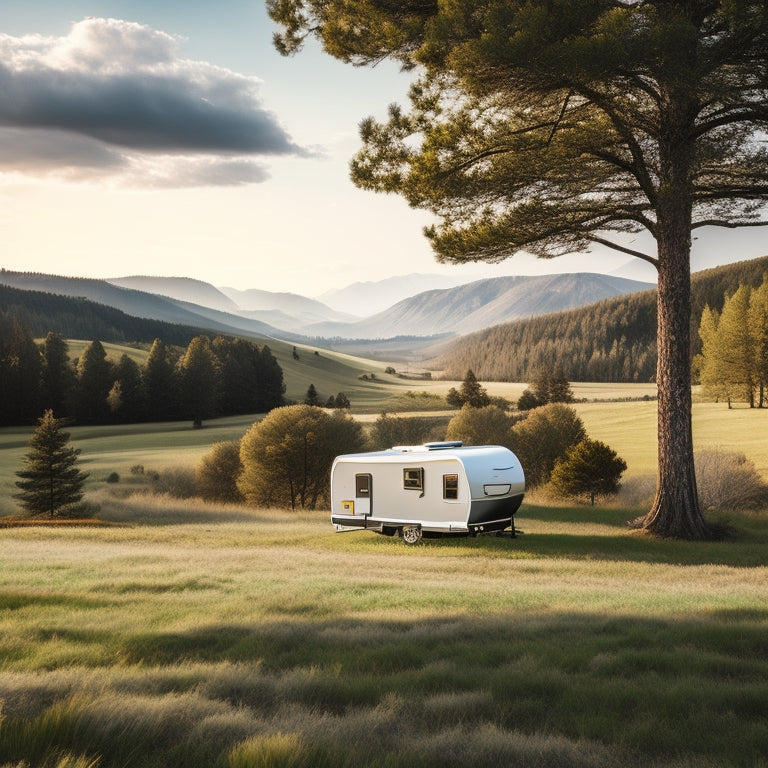
What Solar Panels Are Best for RVs and Motorhomes?
Share
When selecting solar panels for your RV or motorhome, prioritize high-efficiency models that strike a balance between power output and cost. Take into account factors like size, weight, and durability to guarantee smooth integration with your vehicle's electrical system. Monocrystalline panels offer the highest efficiency but come at a higher cost, while polycrystalline and thin-film options provide a good mix of efficiency and affordability. Seek out high-efficiency ratings, compact designs, and durable materials that can withstand harsh weather conditions. Now, explore the key factors to keep in mind when choosing the right solar panels for your RV or motorhome, and find the best solution for your energy needs.
Key Takeaways
• Choose high-efficiency solar panels (>20% efficiency rating) to maximize energy harvesting potential for your RV or motorhome.
• Consider compact and lightweight designs to optimize roof space and reduce overall weight.
• Select a suitable mounting system (fixed, tilt, or adjustable) to ensure secure installation and optimal energy production.
• Ensure voltage and charge controller compatibility with your RV's electrical system and battery configuration.
• Look for certifications like UL compliance and extensive warranty coverage (at least 25 years for solar panels and 10 years for inverters) for a reliable ownership experience.
Types of Solar Panels for RVs
You have three primary types of solar panels to take into account for your RV or motorhome: monocrystalline, polycrystalline, and thin-film panels, each with its unique characteristics, advantages, and disadvantages.
When selecting the right type, consider factors like space constraints, energy requirements, and budget. Monocrystalline panels are the most efficient, but also the most expensive. Polycrystalline panels offer a balance between efficiency and cost, while thin-film panels are the most affordable but less efficient.
If you need flexibility, consider flexible panels, which are lightweight and can be easily installed on curved surfaces. Bifacial panels, on the other hand, can harness energy from both the front and back sides, increasing overall energy output.
When choosing a solar panel, make sure it's designed for RV or motorhome use and meets safety standards. Look for certifications like UL (Underwriters Laboratories) or IEC (International Electrotechnical Commission) to confirm your solar panel is safe and reliable.
Power Output and Efficiency
When selecting a solar panel for your RV or motorhome, it's essential to factor in the power output and efficiency, as these elements greatly influence the panel's capacity to meet your energy requirements.
You'll want to contemplate the maximum power output, measured in watts (W), to make sure it can handle your energy needs. A higher power output means more energy harvested, but it also increases the panel's size and cost.
Efficiency, on the other hand, refers to the panel's ability to convert sunlight into usable energy. Look for panels with high efficiency ratings (>20%) to maximize your energy harvesting potential.
Optimal orientation is also crucial, as it affects the panel's energy output. Make sure to install the panel at an angle that allows it to receive direct sunlight for most of the day. A well-oriented panel can increase energy production by up to 20%.
When selecting a solar panel, prioritize high-efficiency models with a suitable power output for your energy needs. This will ensure you can rely on a consistent supply of renewable energy while on the road.
Size and Weight Considerations
After selecting a suitable solar panel based on power output and efficiency, it's now essential to take into account the physical constraints of your RV or motorhome, as the size and weight of the panel can greatly impact its installation and overall performance.
You need to contemplate the available roof space on your RV or motorhome, making sure that the panel fits comfortably without obstructing ventilation systems, antennas, or other essential features. Compact designs are ideal for RVs and motorhomes, as they provide a high power output while minimizing the footprint.
Additionally, you should opt for solar panels made from lightweight materials, which will reduce the overall weight of your RV or motorhome, enhancing its maneuverability and fuel efficiency. When selecting a solar panel, look for models with a durable and lightweight frame, designed to withstand harsh weather conditions and minimize wind resistance.
Mounting and Installation Options
When it comes to mounting and installing solar panels on your RV or motorhome, you'll need to think about the best approach for your specific setup.
You'll want to choose between roof-mounted solar panels, which provide a sleek, low-profile installation, and tilted adjustable brackets, which allow for efficient energy harvesting.
Both options have their advantages, and understanding their unique benefits will help you make an informed decision for your RV's solar power system.
Roof-Mounted Solar Panels
You can choose from several roof-mounted solar panel options, including fixed-mount, tilt-mount, and adjustable-mount systems, each designed to meet specific RV and motorhome requirements. When selecting a roof-mounted system, consider the importance of roof clearance to guarantee safe passage and avoid obstacles. Make sure the panels are installed at a minimum of 3 inches above the roof to allow for air circulation and ease of cleaning.
Additionally, panel aesthetics play a significant role in your decision-making process. Fixed-mount systems provide a sleek, low-profile design, ideal for those who prioritize a streamlined appearance.
On the other hand, tilt-mount and adjustable-mount systems offer more flexibility, allowing you to adjust the panel angle for efficient energy harvesting. However, these systems may appear more prominent on your RV's roof.
Regardless of the mounting option you choose, it's important to consult with a professional installer to ensure a secure and efficient installation that meets your energy needs while preserving the integrity of your RV's roof.
Tilted Adjustable Brackets
To optimize energy harvesting, consider incorporating tilted adjustable brackets into your roof-mounted solar panel system, which allow for precise angle adjustments to maximize energy output. These brackets enable you to fine-tune the angle of your solar panels to match the changing sun angles throughout the day, guaranteeing you're generating the most power possible. This is particularly crucial for Off Grid Adventures, where every watt counts.
When camping in the wilderness, every ounce of energy is precious. With tilted adjustable brackets, you can adjust the angle of your solar panels to compensate for the changing sun angles, ensuring you're always generating maximum power. This means more Camping Freedom, as you'll have the confidence to venture further off the grid, knowing your solar panel system is working efficiently.
When selecting tilted adjustable brackets, look for durable, corrosion-resistant materials that can withstand harsh outdoor conditions. Make sure the brackets are designed for your specific solar panel model and are easy to adjust, even when you're on the move.
Budget-Friendly Solar Panel Options
Renewable energy enthusiasts on a tight budget can still harness the power of the sun with affordable solar panel options that won't break the bank. If you're looking to reduce your reliance on fossil fuels without draining your wallet, consider budget-friendly solar panel options specifically designed for RVs and motorhomes.
You can achieve significant cost savings by opting for more affordable solar panels. For instance, you can save up to 30% on your energy costs by installing a budget-friendly solar panel system. Additionally, many budget-friendly options are designed for DIY installation, which eliminates the need for professional installation costs. This not only saves you money but also empowers you to have complete control over the installation process.
When selecting budget-friendly solar panels, look for options with a high power-to-weight ratio, which guarantees maximum energy output while minimizing weight and space requirements.
Also, consider solar panels with a durable and weather-resistant design to withstand the harsh outdoor conditions of RV travel. By choosing the right budget-friendly solar panel option, you can enjoy the benefits of renewable energy without breaking the bank.
High-Efficiency Solar Panel Choices
High-efficiency solar panels, boasting conversion rates of 20% or higher, offer a significant boost in energy production for RVs and motorhomes, making them an attractive option for those seeking maximum power output. As you consider upgrading your energy harvesting system, high-efficiency solar panels are worth exploring. These cutting-edge panels incorporate the latest Solar Panel Innovation, ensuring top-notch Energy Harvesting Technology.
Some key benefits of high-efficiency solar panels include:
-
Increased energy production: High-efficiency panels can generate more power per hour of sunlight, making them ideal for RVs and motorhomes with high energy demands.
-
Compact design: With higher efficiency rates, you can achieve the same power output with fewer panels, freeing up valuable roof space.
-
Improved durability: High-efficiency panels are built with advanced materials, ensuring they can withstand the rigors of the road and harsh weather conditions.
Durability and Weather Resistance
When selecting high-efficiency solar panels for your RV or motorhome, you'll want to prioritize those that can withstand the harsh conditions of the open road, as well as extreme weather events. Importance and weather resistance are vital factors to take into account, as your solar panels will be exposed to various environmental stressors, such as coastal exposure, extreme temperatures, and humidity.
Look for solar panels with a high IP (Ingress Protection) rating, which indicates their ability to resist water and dust ingress. A higher IP rating guarantees your solar panels can withstand harsh weather conditions, including heavy rain and snow. Additionally, consider solar panels with a durable anodized aluminum frame, which provides added protection against corrosion and physical damage.
Compatibility With RV Systems
Your RV's electrical system requires a solar panel setup that seamlessly integrates with its existing components, so it's important to verify that the solar panels you choose are compatible with your RV's electrical architecture.
System integration is vital to ensure electrical harmony and prevent any potential safety hazards.
When selecting solar panels, you should consider the following key factors to guarantee compatibility:
-
Voltage Compatibility: Confirm the solar panels' output voltage matches your RV's electrical system voltage (12V or 24V) to prevent damage or malfunction.
-
Charge Controller Compatibility: Verify that the solar panels' charge controller is compatible with your RV's battery type (AGM, lithium, or flooded) and configuration (series or parallel).
-
Electrical Load Management: Consider the total electrical load of your RV's appliances and make sure the solar panel system can handle the maximum load without overloading the electrical system.
Certifications and Warranty Support
In addition to ensuring compatibility, you should also look for solar panels that carry reputable certifications and come with thorough warranty support to guarantee a reliable and hassle-free ownership experience.
When it comes to certifications, look for UL compliance, which confirms the solar panels meet the safety standards set by Underwriters Laboratories. This certification is vital, as it guarantees the solar panels are safe for use on your RV or motorhome.
In terms of warranty support, you want to make sure the manufacturer provides extensive coverage that includes insurance coverage for defects, repairs, and replacements. A good warranty should encompass the solar panels for at least 25 years, with a minimum of 10 years for the inverters.
Here's a summary of what to look for in certifications and warranty support:
| Certification/Warranty | Description |
| UL Compliance | Confirms solar panels meet safety standards set by Underwriters Laboratories |
| Warranty Coverage | Extensive coverage for defects, repairs, and replacements, including insurance coverage |
| Warranty Duration | Minimum of 25 years for solar panels and 10 years for inverters |
Frequently Asked Questions
Can I Use a Single Solar Panel for My Entire Rv?
When sizing your solar panel, you'll need to take into account your RV's power needs, not just relying on a single panel. You'll also need to factor in wiring considerations, ensuring safe and efficient energy transmission throughout your RV.
How Do I Clean and Maintain My RV Solar Panels?
You'll guarantee peak performance by regularly inspecting your panels for debris and damage, then establishing a cleaning schedule to remove dirt and grime, which can reduce energy output by up to 25%.
Can I Charge My RV Batteries During the Night?
"As the sun dips below the horizon, you can still fuel your RV adventures by harnessing nighttime charging, optimizing battery efficiency through advanced controllers that regulate power flow, ensuring a safe and efficient recharge."
Do RV Solar Panels Work During Cloudy or Rainy Days?
When you're boondocking, you'll wonder if RV solar panels work on cloudy or rainy days. The answer is yes, but with reduced efficiency. Cloudy Day Performance drops to 10-20% of peak output, while Rainy Weather Efficiency decreases to around 5-10%, still providing some power, but not at its best.
Are RV Solar Panels Compatible With Generators or Inverters?
As you navigate the complex landscape of RV power systems, you'll find that your solar panels can harmoniously coexist with generators or inverters, thanks to parallel charging and power synchronization, ensuring a seamless flow of energy.
Related Posts
-

Why Choose Recycled Paper for Earth-Conscious Business?
By choosing recycled paper, you'll greatly reduce your business's environmental impact. You'll lower your carbon foot...
-

Why Choose Cool Roofs in Scorching Climates?
You opt for cool roofs in scorching climates because they enable you to reclaim control over your energy consumption ...
-

3 Earth-Loving Furniture Tips for Energy-Smart Homes
When furnishing your energy-smart home, you have the power to reduce your carbon footprint greatly by making consciou...


